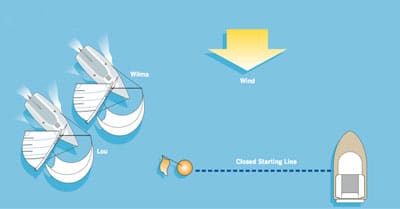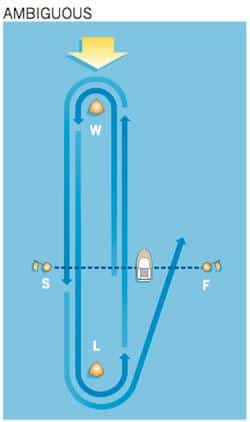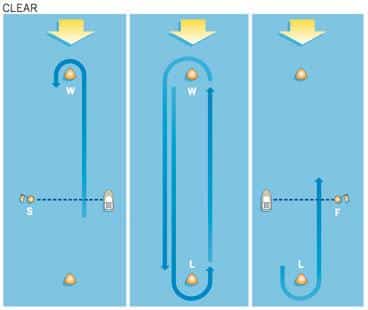
FTE: Clarifying Closed Lines
This month’s column was inspired by an e-mail from a reader, Michelle McPeek, in which she described a situation that happens with great regularity. The club is planning on running multiple races for several fleets. The race committee is small and wants to crank out races at a rapid pace to maximize the fun for the sailors. It sets a windward mark, W, and a leeward mark, L, and then anchors the committee boat about a third of the way up from L to W. A starting line pin, S, is set off the port side of the committee boat and a finishing line pin, F, off the starboard side. The committee simply announces, “windward-leeward course, twice around, marks to port. The start-finish line is closed.”
This course setup has several features race committees love. If the wind is steady, the committee boat probably will not have to up anchor until the race day is over. As soon as a fleet finishes, it can be restarted immediately without waiting for the other fleets to finish. During a starting sequence for one fleet, boats from other fleets can finish on the separate finish line or, if they are on a leg from W to L or vice versa, they will pass outside the start-finish line without interfering with the fleet that is starting.
This process generally works very well. There are, however, a few problems with it that may not surface very often, but when they do, can result in protests or redress requests that will be very difficult to decide. These problems can be avoided with carefully worded sailing instructions (and attentive reading on the competitor’s part), but you will not find language for such sailing instructions in the Sailing Instruction Guide in Appendix L in the rulebook. That guide is designed primarily for major championship regattas, where this course configuration is rarely used.
Let’s examine some of the questions that have arisen. What is a “closed start-finish line?” Must a boat cross the finish line at the end of the first lap? Or the starting line? If a boat crosses the starting line while on the run from W to L, may she correct her error as provided for in Rule 28.1? Are S and F marks for boats while they are sailing from W to L or from L to W? Are buoys S or F or the start-finish line obstructions for boats on those legs? If two boats are beating from L to W and approaching the starting line, can one of them hail for room to tack under Rule 20.1? If two boats are overlapped as they pass S on the run from W to L, does Rule 18 apply? Or Rule 19? Or both? Or neither?
If the only sailing instruction covering the course were the one I quoted in the opening paragraph, these questions would not have answers under the racing rules. However, a carefully written sailing instruction answers all these questions clearly, and tremendously reduces the likelihood of difficult protests or redress requests. Here is a sailing instruction that I recommend be used when a race committee wishes to “close” the start-finish line.
After completing the first leg of the course, a boat shall not cross the starting line. A boat shall not cross the finishing line until she is completing the last leg of the course and finishes. A boat that breaks this rule shall not correct her error. However, she will be exonerated if she takes a Two-Turns Penalty (see rule 44.2). This changes rule 28.1. On a leg of the course from W to L or from L to W, boats may leave the line between S and F either to port or to starboard.

For reasons of safety, on legs of the course from W to L or from L to W, the starting and finishing lines and the buoys S and F are, taken together, one obstruction, and therefore rules 19 and 20 may apply between boats while they are approaching and passing it.
Some explanation is in order for some of the wording I’ve used in composing these sailing instructions. The phrase “After completing the first leg of the course” is included to avoid penalizing the following innocent action by a boat. Suppose after the starting signal, flag X is raised (meaning one or more boats were over early). Larry knows that he was very close to the line and, being a cautious fellow, returns to the pre-start side of the starting line and then crosses it again. If, in fact, he had not been over early, and if the sailing instruction had not included that phrase, Larry would have unwittingly broken the sailing instructions.
Here’s why I suggest changing Rule 28.1 so that a boat cannot correct her error if she crosses the starting or finishing line when it is “closed.” The whole purpose of closing the lines is so that a boat sailing from W to L or from L to W does not interfere with boats that are starting or finishing. If we allow such a boat to correct her error (which would mean unwinding her string by crossing the line a second time in the opposite direction), then we would be doubling the risk that she would interfere with either a start or a finish.
Under the instruction I suggest, on a leg from W to L or from L to W, the line between S and F and the buoys S and F, taken together as one object, is not a mark because the sailing instructions do not “require a boat to leave it on a specified side” (see the definition Mark). It’s necessary to make that object an obstruction to cover the situation shown in the diagram on the previous page. After rounding mark W, Lou and Wilma have been overlapped for several lengths as they approach buoy S and the starting line.
Suppose, as is quite common, buoy S is so small that, if a boat were sailing directly toward it and one of her hull lengths from it, she would not have to change course substantially to pass it. In that case, if a sailing instruction did not designate it to be part of an obstruction, it would not be one (see the definition Obstruction). If buoy S were neither a mark nor an obstruction, Wilma would not be entitled to room from Lou. Because buoy S and the starting line are part of an obstruction, Rule 19.2(b) entitles Wilma to room to pass between Lou and buoy S.
You are probably wondering why, “for reasons of safety” was included in the instruction designating the obstruction. Here’s the reason: Suppose that, on the windward leg from L to W, Annie and Bill are approaching the middle of the starting line sailing close-hauled on starboard tack. Annie is almost clear ahead of Bill and he is so close to her windward side that there is not room for her to tack without colliding with him. She would like to hail for room to tack and avoid the starting line. However, Rule 20.3 states that a boat in Annie’s position “shall not hail unless safety requires her to make a substantial course change to avoid the obstruction.”

One of the reasons for making the starting line part of an obstruction is to enable the race committee to start a fleet in relative safety while the other fleets may be passing near the starting line on their way from L to W. By declaring that the starting line is part of an obstruction “for reasons of safety,” we enable Annie to use Rule 20 to obtain room to tack without breaking Rule 20.3.
If your club or fleet uses the kind of course set up described here, it might be a good idea to show this column to your race committee chairman.









